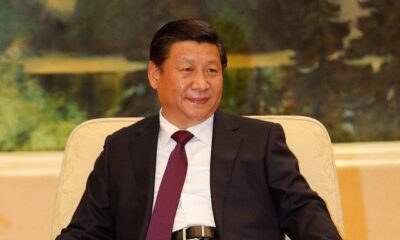

Energy
China’s Coal Production Falls 3.5% To 3.68b Tonnes: Reaction
China’s coal imports are a their slowest rate of growth since 1998. At the beginning of January China declared no new coal mines for the next three years. And China’s coal production has fallen by 3.5%. This is the reaction to the latest news.
Luke Sussams, senior researcher at the Carbon Tracker Initiative said: “Carbon Tracker’s latest analysis concluded that no new coal mines are needed in the next decade globally to stay within 2C of global warming. China has aligned with this trajectory, recently ruling out any new mines for the next three years. China’s economic growth is slowing faster than many expected, which today’s official statistics show has profound effects on energy and electricity demand, as highlighted in our ‘Lost in Transition’ report published late last year.
“China is demonstrating that it is possible for even the largest nations to rapidly shift their economies within climate and environmental limits under the right conditions – this should serve as a model for all developing countries attempting to grow their economies whilst remaining within the climate trajectory enshrined at COP21.”
LI Junfeng, Director General, National Climate Change Strategy Research and International Cooperation Center, said: “A few other figures coming from today’s announcement and recent news is sending the strong signal that the clear acceleration of China’s energy transition while the economy is declining. For example, last year, power generation dropped 0.2%, the first time negative growth in the last half century, and the power consumption only grew 0.5%.
“Meanwhile, non-fossil power generation increased more than 20%, among which hydro, wind, nuclear, solar take account 71%, 14%,12%, 3% respectively. It means that thermal power generation dropped more than 4%, which indicates that non-fossil energy would not only meet the additional demand, but also the existing demand. I think thermal power generation will continue to drop with an annual speed of 2-4% and the non-fossil power generation will stay in a high growth rate of 20%.
“Coal production and consumption has entered into a turning point since 2014. Even if it bounces back in the future, it would not be big bounce. Declining is the long term trend. Coal power capacity will be more of a peak adjustment to allow more non-fossil power capacity’s operation. Global carbon emission in 2015 may reach zero or even negative growth in 2015 due to this mild growth of China’s energy consumption. This trend may continue for 3-5 years or even longer.”
WANG Tao, Assistant Director, China Business News Research Institute, said: “From the data released today by China’s national statistics authority, we could see that China’s economy is still in the process of transition, the New Normal is yet a norm. The figure of energy consumption only grew 0.9% in 2015, the lowest ever growth rate since 1998, just like the GDP rate.
“The transition of economic structure also was also reflected on the power generation and consumption data. The power generation dropped 0.2% in 2015, comparing to 3.2% increase in the last year. Within, the consumption from the industrial sector continue declining, when service and residence sector’s consumption keep growing. The signal is transition is clear.
“From the energy structure, coal’s proportion continue dropping since its first drop since 2014. The amount of thermal power decreased 2.8% in 2015, it not only indicates the overall weak demand, but also the growing percentage of non-fossil fuel power generation.”
Alvin Lin, China Climate and Energy Policy Project Director, Natural Resources Defense Council, said; “The 3.5 percent drop in 2015 for China’s coal production, 2.8 percent drop in thermal (primarily coal) power production, and similar decreases in coal-intensive heavy industry production such as iron and steel and cement show that China’s economy and energy structure is moving decisively towards less coal-intensive forms of economic activity and production. Renewables investment in China last year, $110 billion, was at an all time high, and clean energy is steadily replacing coal fired power in the generation mix. With continuing efforts to reduce air pollution and climate emissions, 2016 is likely to be another crucial year for China in its efforts to cap coal consumption and rebalance its economy toward a more sustainable track.”
Anders Hove, Associate Director of Research, Paulson Institute, said: “The fact that coal capacity and investment in new coal capacity all grew strongly appears to be an issue worth drawing more attention to. Thermal generation grew 7.8% and investment in thermal power rose 22%. While the argument can be made that new coal plants are needed in some places, and are cleaner than old ones being retired, some of these investments have the potential to become “stranded assets”—namely, investments that have to be closed down prematurely—under scenarios where China’s coal use peaks early. Some observers, including the International Energy Agency, believe China coal use has already peaked.
“Operating hours at coal plants fell 10% in 2015, indicating that over-investment in new coal plants is hurting industry bottom lines. The coal power industry faces a dilemma, where each new plant brought online in a stagnant demand environment hurts the returns of the existing fleet, but not bringing new plants online leads to falling market share and revenue for individual companies, most of which are state-owned. As Greenpeace noted last fall, 2015 seems to have seen a rush of new approvals for coal plants that is out of step with efforts to cap coal consumption in certain regions.
“Climate Policy Initiative, in an excellent paper released in December, showed that such approvals appear to result from the skewed incentives in the power system, which favor builders of new coal plants (generally all large state owned enterprises) with advantageous contracts, and thereby crowd out renewable energy. Notwithstanding new investment in grid infrastructure, without addressing current over-investment in coal plants and reforming the compensation structure for coal plants, China cannot achieve its policy objectives with respect to clean energy—as the Paulson Institute discussed in a power sector paper published last September. Recent power reform documents underlined this fact by laying out a potential “black list” for companies or banks that build or finance coal plants that are out of step with policies to curb coal consumption.”
Ben Caldecott, Programme Director, Smith School of Enterprise and the Environment, University of Oxford, said: “Great strides continue to be made in China in terms of growing clean energy investment and improving energy efficiency. This has significant implications for coal-fired power stations in China – in terms of utilisation rates and profitability – as well as for thermal coal miners that have made big bets on seriously flawed projections of China’s future demand for imported coal.”
Lauri Myllyvirta, Energy Desk, GREENPEACE, added: “The growth of power generation from non-fossil sources in China in the past few years is the largest deployment of renewable energy in history, for any country. This has enabled China to cover a 20% increase in power demand from 2011 to 2015 by clean energy while reducing coal use in the power sector, an astounding achievement. Going forward, as deployment of renewable energy accelerates and power demand growth slows, the fall in power sector coal demand will be much faster. Changing economic structure means that coal burning in key heavy industry sectors will also fall. This is an unprecedented opportunity for peaking global coal use and CO2 emissions.”


 Environment10 months ago
Environment10 months agoAre Polymer Banknotes: an Eco-Friendly Trend or a Groundswell?

 Environment11 months ago
Environment11 months agoEco-Friendly Home Improvements: Top 7 Upgrades for 2025

 Features9 months ago
Features9 months agoEco-Friendly Cryptocurrencies: Sustainable Investment Choices

 Features10 months ago
Features10 months agoEco-Friendly Crypto Traders Must Find the Right Exchange






























